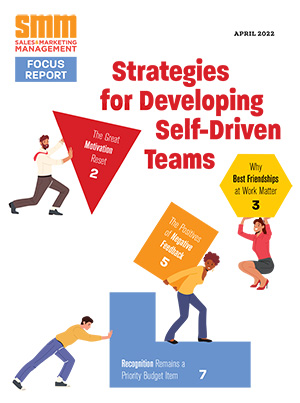
“Different strokes for different folks,” the adage states. But maybe we’ve been missing the most important message from that all along. It’s not so much that different people enjoy different things, but that everybody enjoys something.
A recent study of sales organizations at top-performing companies reveals that they are more likely to use recognition in the form of non-cash rewards. Specifically, a majority (55 percent) of respondents to a recent survey conducted by Aberdeen Group and distributed by the Incentive Research Foundation (IRF) indicate that non-cash incentives and rewards are a “vital component” of sales performance management. Fifty-seven percent say that “internal recognition for positive performance” is a critical non-financial motivator.
The February 2013 Aberdeen Research Brief, “Non-Cash Incentives: Best Practices to Optimize Sales Effectiveness,” explores how best-in-class organizations extend beyond simple cash compensation to use non-cash incentives and rewards as a vital part of their B2B sales performance management efforts.
A look at best-in-class companies
Aberdeen Group, a leading provider of fact-based research helping organizations and individuals make better business decisions, surveyed 312 end-user organizations to better understand how sales performance management is most effectively deployed. BIC firms (those comprising the top 20 percent) had higher customer retention rates, higher year-over-year increase in the number of sales reps achieving quota and a much larger increase in deal size/contract value than industry average firms or ‘laggard firms’ (those comprising the bottom 30 percent).
The Research Brief, supported and distributed by the IRF, found that organizations with formal internal sales employee recognition programs had nearly 15 percent higher team quota attainment and 6 percent higher customer renewal rate. In fact, 100 percent of BIC organizations use incentive travel to motivate their sales force.
The study also found that BIC firms were:
• Eleven percent more likely to offer verbal praise, 90 percent more likely to offer public recognition and 94 percent more likely to offer peer-to-peer recognition for progress towards goal versus all other firms
• Twenty-three percent more likely than all others to offer group travel, 75 percent more likely to offer company-sponsored events and 60 percent more likely to offer peer-to-peer recognition as a year-end sales incentive
• Twenty-six percent more likely than all others to list teamwork as a very important part of the sales process - and 47 percent more likely than laggard firms
You can download the full report at TheIRF.org. The IRF funds and promotes research to advance the science and enhance the awareness and application of motivation and incentives in business.


